A History of Football Kit Design in England and Scotland
(4) The Inter-War Years 1919-1939
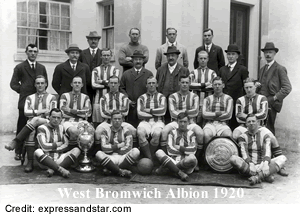 When the Football League resumed in 1919 the First and Second
Divisions were both extended from 20 to 22 clubs each. The following season
the clubs of the First Division of the Southern League were incorporated as associate members
of the Football League to form Division Three. A year later the leading northern
non-league sides were incorporated and the regional Third Divisions South and
North were formed. The competition could now be considered truly national.
When the Football League resumed in 1919 the First and Second
Divisions were both extended from 20 to 22 clubs each. The following season
the clubs of the First Division of the Southern League were incorporated as associate members
of the Football League to form Division Three. A year later the leading northern
non-league sides were incorporated and the regional Third Divisions South and
North were formed. The competition could now be considered truly national.
The Scottish Football League also resumed in 1919 but without a Second Division. The surviving members formed a rebel Central League that proved so succcessful that it was incorporated into the Scottish League structure in 1921. Two years later a Third Division was added but this proved unsustainable and it collapsed in 1925-26 with fixtures incomplete.
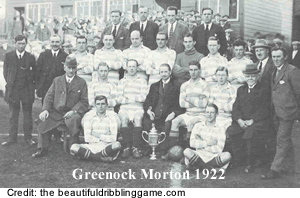 In 1920 Harold and Wallace Humphreys founded the Humphrey Brothers Clothing Company which they renamed Umbro in 1924. From humble beginnings in a small workshop in Wilmslow, Cheshire, Umbro rapidly grew and soon was challenging Bukta to supply kit to Football League teams as well as those in non-league competitions.
In 1920 Harold and Wallace Humphreys founded the Humphrey Brothers Clothing Company which they renamed Umbro in 1924. From humble beginnings in a small workshop in Wilmslow, Cheshire, Umbro rapidly grew and soon was challenging Bukta to supply kit to Football League teams as well as those in non-league competitions.
There was little innovation in kit design during the 1920s with styles remaining much as they were before the war. Laced crew necks were very common and plain jerseys were the most popular design in both England and Scotland. However, while stripes were still the second most popular design in the Football League, hooped jerseys were Scotland's second most popular design.
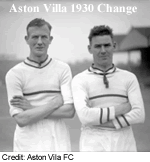 In 1921 the Football League ruled that the visiting club should change shirts in the event of a colour clash (previously the senior team retained their first choice kit). As a rule teams would only change their shirts, matched with their regular shorts and stockings. Most change shirts were standard designs but Aston Villa preferred something rather more distinctive.
In 1921 the Football League ruled that the visiting club should change shirts in the event of a colour clash (previously the senior team retained their first choice kit). As a rule teams would only change their shirts, matched with their regular shorts and stockings. Most change shirts were standard designs but Aston Villa preferred something rather more distinctive.
Also in 1921 the International Football Association Board ruled that goalkeepers in international matches should wear deep-yellow jerseys. With sublime arrogance the 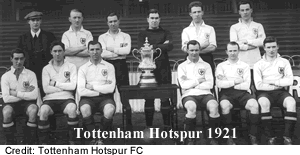 FA delegate proposed that the jerseys should be red but this was rejected after a protest from the FA of Wales.
FA delegate proposed that the jerseys should be red but this was rejected after a protest from the FA of Wales.
Tottenham Hotspur won the FA Cup in 1921 wearing shirts supplied by Bukta that had a crest featuring a fighting 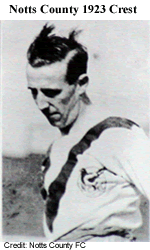 cockerel. While it was now normal for finalists to add a badge to their shirts for the occasion, this is the first recorded example of a mascot being involved. The fighting cock became a permanent fixture on Spur's shirts although he has lost weight over the years. Notts County followed suit a couple of years later, adding a magpie to their own tops.
cockerel. While it was now normal for finalists to add a badge to their shirts for the occasion, this is the first recorded example of a mascot being involved. The fighting cock became a permanent fixture on Spur's shirts although he has lost weight over the years. Notts County followed suit a couple of years later, adding a magpie to their own tops.
In 1924 Aston Villa made a slight alteration to the neckline and cuffs of their jerseys. At the time there were four other teams in the Football League wearing the 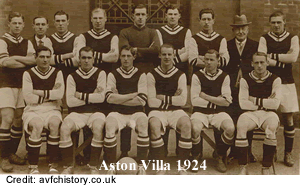 famous claret and blue jerseys and it seems likely that Villa wanted to restore a degree of distinctiveness to their own strip.
famous claret and blue jerseys and it seems likely that Villa wanted to restore a degree of distinctiveness to their own strip.
In 1927 the Scottish Football League's management committee decided that clubs should wear white shorts when at home, black when playing away. The reasons behind this bizarre rule are lost and it proved very unpopular with clubs and fans alike. It was rescinded at the SFL's Annual General Meeting in June 1929.
Motherwell had adopted their familiar claret and amber colours in 1913 but it was in September 1928 that 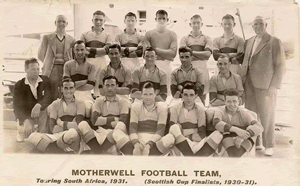 their most iconic strip appeared for the first time. An amber shirt with a wide claret band and armlets was teamed with white knickers. There were some changes to the detailing down the years but this classic design remained substantially unchanged for over 40 years until it was dropped in 1969. Since then it has been revived many times and in the 21st century it once again
their most iconic strip appeared for the first time. An amber shirt with a wide claret band and armlets was teamed with white knickers. There were some changes to the detailing down the years but this classic design remained substantially unchanged for over 40 years until it was dropped in 1969. Since then it has been revived many times and in the 21st century it once again 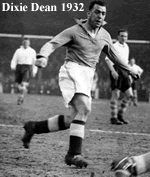 became 'Wells signature look.
became 'Wells signature look.
The winds of change started to blow during the following decade. The first innovation was so subtle it may have gone almost unnoticed. In 1930 Everton had a blue stripe sewn into the sides of the team's shorts. This had not been unusual in Victorian times but trim on shorts then disappeared completely. This minor change became part of the Toffees' signature look and no matter that their shirts were always very plain, supporters could always tell it was their team by the stripe, which remained until 1966.
Early in 1933 Arsenal's manager, Herbert Chapman was in conversation with the celebrated cartoonist, Tom Webster, who described playing golf with the chairman of Chelsea FC who had worn a sleeveless blue sweater over a white 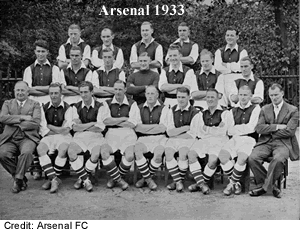 shirt. Chapman, armed with a sketch that Webster drew at his request, ordered a set of sleeveless red viyela sweaters which could be worn over the white shirts that were the team's
shirt. Chapman, armed with a sketch that Webster drew at his request, ordered a set of sleeveless red viyela sweaters which could be worn over the white shirts that were the team's 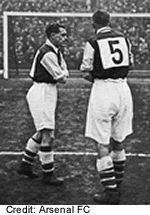 change strip. This proved impractical and when the Gunners finally took to the field in their new rig on 4 March 1933 it was in very smart red and white shirts. To make it even easier for team-mates to pick each other out, Chapman added navy and white stockings to the set.
change strip. This proved impractical and when the Gunners finally took to the field in their new rig on 4 March 1933 it was in very smart red and white shirts. To make it even easier for team-mates to pick each other out, Chapman added navy and white stockings to the set.
Chapman also experimented with numbered shirts in 1928 but these were not sanctioned by the Football League Management Committee. Chapman persisted and Arsenal wore them again in a friendly against FC Vienna in December 1933. It was not until 1939 that numbered shirts were approved.
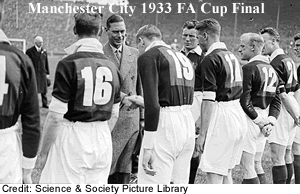 It is not often that the FA could be considered at the forefront of innovation but they did sanction the use of shirt numbers in the 1933 FA Cup final between Everton and Manchester City. Everton wore 1-11 while City had 12-22. As the teams
It is not often that the FA could be considered at the forefront of innovation but they did sanction the use of shirt numbers in the 1933 FA Cup final between Everton and Manchester City. Everton wore 1-11 while City had 12-22. As the teams 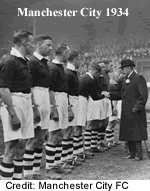 normally played in blue both had to change and the FA, in its wisdom offered a choice of white or scarlet alternatives. Everton chose white so it was City who had to play in the colours of their closest rivals. They lost that day but were back a year later when they beat Portsmouth. The maroon shirts they wore in this match were supplied by
normally played in blue both had to change and the FA, in its wisdom offered a choice of white or scarlet alternatives. Everton chose white so it was City who had to play in the colours of their closest rivals. They lost that day but were back a year later when they beat Portsmouth. The maroon shirts they wore in this match were supplied by 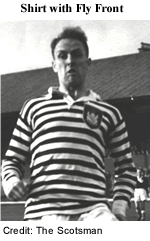 Umbro, the first time the Cheshire company had provided kit for such an illustrious occasion. The hooped stockings worn by City were a new style that became very popular during the decade.
Umbro, the first time the Cheshire company had provided kit for such an illustrious occasion. The hooped stockings worn by City were a new style that became very popular during the decade.
The ubiquitous laced crew-necks that were so common in the previous two decades now all but disappeared, replaced by collars. These came in 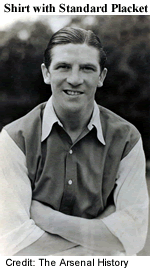 two varieties: the rugby-shirt collar with a fly-front that concealed the buttons and shirts with a standard placket. This usually extended well down the front of the shirt. It was not unusual for teams to switch between the two styles from one season to another or even mid-season depending on what their suppliers had available.
two varieties: the rugby-shirt collar with a fly-front that concealed the buttons and shirts with a standard placket. This usually extended well down the front of the shirt. It was not unusual for teams to switch between the two styles from one season to another or even mid-season depending on what their suppliers had available.
Umbro's 1935 catalogue reveals that the company offered 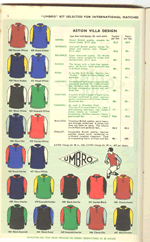 football jerseys in a wide range of colour combinations and quality. The "Nipper" for example was "Sound British quality, suitable for junior clubs," and at 22/9 (£95 in 2023 prices) for a dozen the cheapest on offer. At the top end of the scale was the "Finalist" at 100/- per dozen (£418) offering "Insuperable British quality, heaviest possible tested yarns, reinforced to withstand roughest treatment. Dyes of outstanding merit, brilliant and fast."
football jerseys in a wide range of colour combinations and quality. The "Nipper" for example was "Sound British quality, suitable for junior clubs," and at 22/9 (£95 in 2023 prices) for a dozen the cheapest on offer. At the top end of the scale was the "Finalist" at 100/- per dozen (£418) offering "Insuperable British quality, heaviest possible tested yarns, reinforced to withstand roughest treatment. Dyes of outstanding merit, brilliant and fast."
Umbro's knickers ranged from the "Laddie" (Fleecy lined. Full cut 10/6 (£42) per dozen in white) to the formidable "Ironclad" (Guaranteed untearable Drill. Fleecy lined 40/- (£167) per dozen in black or navy). It is worth noting that knickers were still only available in white, black and navy. 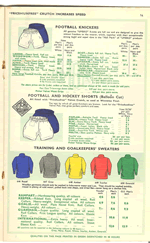 Fast dye trimmings could be added down the sides of knickers for an additional 3/9 (£16) a dozen.
Fast dye trimmings could be added down the sides of knickers for an additional 3/9 (£16) a dozen.
The front cover of the 1935 catalogue celebrated the fact that both teams in the FA Cup Final had worn Umbro kit that year. For the third final in succession both teams had 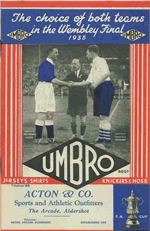 changed because of a colour clash and on this occasion shirts with short sleeves appeared for the first time, worn by Sheffield Wednesday. As players usualy rolled the sleeves to the elbow anyway, it was hard to detect any difference but the following season several teams adopted this new style.
changed because of a colour clash and on this occasion shirts with short sleeves appeared for the first time, worn by Sheffield Wednesday. As players usualy rolled the sleeves to the elbow anyway, it was hard to detect any difference but the following season several teams adopted this new style.
In 2014 Peter Holmes from the National Football Museum contacted HFK concerning the West Bromwich Albion shirt from the 1935 final that is in their collection. He described this as having a "silky feel" although it was definitely not made of real silk. A regular contributor who had owned one of these shirts described how it was exceptionally soft and could be squeezed into a ball that would fit into the hand. After consulting with a textile expert, HFK established that 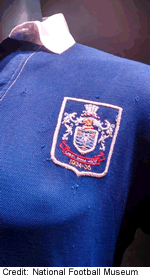 these shirts were probably made from rayon, an artificial fabric that is lightweight with good absorption properties and has the texture of silk. This may be the first football shirt to be made from artificial fibre to have been produced.
these shirts were probably made from rayon, an artificial fabric that is lightweight with good absorption properties and has the texture of silk. This may be the first football shirt to be made from artificial fibre to have been produced.
(The catalogue images are scaleable - click on the pictures to see the larger version.)
While most teams wore strip chosen from the catalogues of Umbro and Bukta a few turned out in unique jerseys. Bradford (Park Avenue) were always a modest club and one of a small number with two different traditional colour schemes. Their 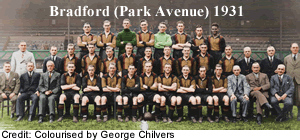 original colours were red, amber and black hoops, a legacy of their origins as a rugby team. They adopted green and white hoops after a former Celtic player, Tom Maley took over as manager in 1911. Bradford periodically switched from one to the other (the modern phoenix club has maintained this tradition). In the 1931-32 season they wore extravagant tops in their original colours. A curious detail is that some players have amber sleeves while others have black.
original colours were red, amber and black hoops, a legacy of their origins as a rugby team. They adopted green and white hoops after a former Celtic player, Tom Maley took over as manager in 1911. Bradford periodically switched from one to the other (the modern phoenix club has maintained this tradition). In the 1931-32 season they wore extravagant tops in their original colours. A curious detail is that some players have amber sleeves while others have black.
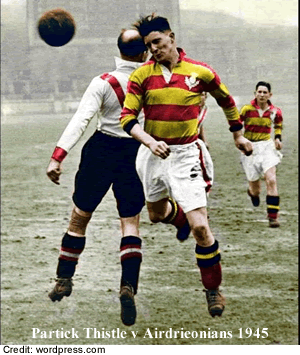 In January 1935 Partick Thistle dropped their rather commonplace navy jerseys in favour of a dazzling outfit consisting of broad red and yellow hooped jerseys with black trimmings, teamed with white knickers complete with a red stripe down the side seams. The Jags wore this distinctive strip for 36 years until it was dropped in favour of something altogether more bland in 1971.
In January 1935 Partick Thistle dropped their rather commonplace navy jerseys in favour of a dazzling outfit consisting of broad red and yellow hooped jerseys with black trimmings, teamed with white knickers complete with a red stripe down the side seams. The Jags wore this distinctive strip for 36 years until it was dropped in favour of something altogether more bland in 1971.
Northampton Town added horizontal bands to their traditional claret jerseys in 1936. These were still in 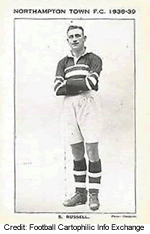 use well after the end of the war, alternating with plain claret tops. Clothing was still rationed and the club would appeal to supporters to donate spare coupons to buy replacements. A player of the period recalled that "when a team mate went down injured the manager was more concerned about the shirt than the player". (The Cobblers: History of Northampton Town, FC Frank Garde 1985).
use well after the end of the war, alternating with plain claret tops. Clothing was still rationed and the club would appeal to supporters to donate spare coupons to buy replacements. A player of the period recalled that "when a team mate went down injured the manager was more concerned about the shirt than the player". (The Cobblers: History of Northampton Town, FC Frank Garde 1985).
Since joining the newly formed Third Division in 1920, Bristol Rovers had hardly set the world alight, wearing strips that 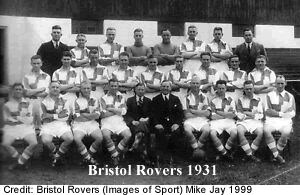 were as nondescript as their performances. In 1931 their Secretary/Manager Capt Prince Cox decided to smarten his team up with bright blue and white quartered shirts that, he thought, would make them look taller. Although this was not an original design it had not been worn in the Football League since before the First World War. Quarters became synonymous with the club but were dropped in the 1960s when there was a mania to "modernise." Supporters were delighted when they were reinstated in 1973.
were as nondescript as their performances. In 1931 their Secretary/Manager Capt Prince Cox decided to smarten his team up with bright blue and white quartered shirts that, he thought, would make them look taller. Although this was not an original design it had not been worn in the Football League since before the First World War. Quarters became synonymous with the club but were dropped in the 1960s when there was a mania to "modernise." Supporters were delighted when they were reinstated in 1973.
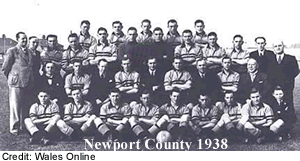 Another club that hoped a change of colours would improve their fortunes was Newport County who played in red and white stripes between 1935 and 1938, when it was decided to revert to their traditional amber and black. A novel design with three black rings across the body and sleeves was ordered but the supplier misunderstood and reversed the colours. County played in black shirts until the mistake was rectified.
Another club that hoped a change of colours would improve their fortunes was Newport County who played in red and white stripes between 1935 and 1938, when it was decided to revert to their traditional amber and black. A novel design with three black rings across the body and sleeves was ordered but the supplier misunderstood and reversed the colours. County played in black shirts until the mistake was rectified.
In September 1939 the Football League and Scottish Football League were abandoned following the outbreak of war with Nazi Germany. Regional competitions were set up but with so many players serving in the armed forces, few of these were completed. Those teams close to naval bases and army garrisons often included famous guest players.
© Dave Moor (2023)